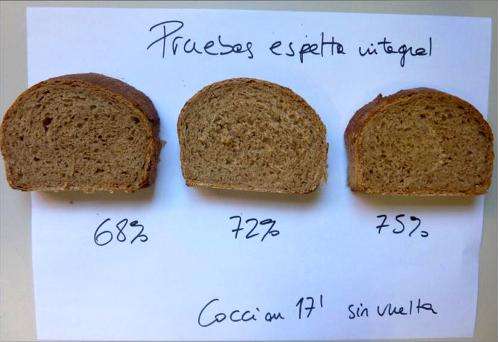Sensory properties, another criteria for wheat breeding

A new study from UPM suggests that bread from certain spelt wheat varieties have differentiated sensory properties that could be considered for future breeding works.
In order to study the influence of wheat varieties in the sensory quality of bread, the research group of Breeding Plants from Universidad Politécnica de Madrid (UPM) has developed the sensory profile of five different wheat varieties—three bread wheat (Triticum aestivum ssp. vulgare L.) and two spelt wheat (T. aestivum ssp. spelta)—and has found significant differences among them. This result has led the team to consider the sensory properties as another criterion of selection for future breeding wheat works. Additionally, they have also designed a training protocol for the panel of judges involved in the bread tastings that would improve the reliability of these tastings.
Spelt wheat is an ancient grain that has regained popularity over the last 20 years because of its nutritional potential and its adaptation to organic farming conditions. In order to study the sensorial differences between the bread made with this type of wheat and the one made with traditional wheat, researchers at UPM used five samples of different grains, two types of spelt and three of baker wheat. The whole study was designed to make the breads from these five grain samples and was considered "monovarietal".
Thus, all grains came from the same place (Vitoria), from the same harvest (2010/2011) and from organic farming. Additionally, all samples were ground with the same grinding diagram and the flour was made into bread following the same protocol, adding sourdough to achieve the best quality in the final product.
After baking the five types of breads, researchers developed the sensory profile. A panel of expert judges was trained for bread tastings. Aroma, appearance, texture and taste were determined.
Firstly, researchers found significant differences among the types of bread, both in the alveoli structure and in the elasticity of bread crumbs made with spelt wheat and bread made with common wheat. Secondly, they found differences in the attributes of smell and taste.
Today, sensory properties are not included as quality parameters for works of selection of new wheat varieties. However, thanks to these results, researchers from UPM suggest including these sensory properties since they have a great relevance in the outcome of the changing process from grain into bread.
Besides, they suggest a protocol for the selection, training, and verification of an expert judge panel to assess the bread quality. This will positively affect on the results that later on will be transferred to the consumers.
More information: "Selection, training and validation process of a sensory panel for bread analysis: Influence of cultivar on the quality of breads made from common wheat and spelt wheat," Journal of Cereal Science, Volume 61, January 2015, Pages 55-62, ISSN 0733-5210, dx.doi.org/10.1016/j.jcs.2014.09.008
Provided by Universidad Politécnica de Madrid




















